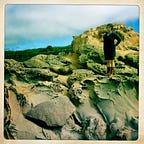Welcome to the Warped World of Apple Maps
Pancaked cars, twisted buildings and melted infrastructure. Apple’s attempts to render reality merely turned it on its head.
The 3D Flyover option in Apple Maps is like Google Earth on acid. Although Flyover was intended to give a real bird’s-eye-view experience of traveling over the map, some renderings make it look like you’re in a lo-fi, post-apocalyptic video game.
For the book The Rendering Eye: Urban America Revisited, historian and author Regula Bochsler has obsessively screenshot droves of the fantastically weird glitches. Co-edited by Philipp Sarasin, The Rendering Eye brings together the buildings, landscapes and roads that Apple Maps has “melted” the most.
“The glitches were the starting point of the project,” says Bochsler who quickly became addicted, furiously grabbing screens and saving images.
“The more I immersed myself into this artificial world, the more I discovered a visual quality beyond the obvious glitches, based on structure, colors, and patterns.”
The Rendering Eye includes only cities in the United States and Canada because at the outset Apple had mapped relatively few territories beyond North America. Already Bochsler has added to the project and her website features cities around the world. She’s capturing the great outdoors too.
“Having started with cityscapes I gradually got more interested in nature, looking for a sort of modern nature morte,” says Bochsler. “I search for pictures in a manner similar to how a photographer wanders across a landscape with her camera.”
The imagery in Flyover is created from data fed back into software from plane-mounted cameras. Distance, palette and spatial relations are all mapped by multi-directional lasers to render 3D models. This massive mapping can be completed with little-to-no human oversight, meaning incongruent details are expected, tolerated and often not even noticed.
Despite how wacky Bochsler makes parts of Flyover appear, it was a huge breakthrough in 3D mapping. It drastically reduced the expense and time required to collect the data necessary to map terrain accurately.
Perhaps not surprisingly, Flyover was developed by the defense industry. Flight simulation, enemy surveillance and strategic mission planning all obvious early uses of 3D mapping.
In 2007, Saab, the Swedish defense and civil security company, created C3 Technologies in order that it could develop its 3D mapping technology for the non-military sector.
Now that we civilians have got a chance to fool around with the software, Apple is working to fix the very flaws and snafus Bochsler’s work exposes. One day, these images will not exist in the program. Bochsler’s diligence means Flyover’s trippy defects will live on.
Just as we look back to the green text of monochrome monitors such as the IBM 1515 with nostalgia, perhaps we’ll one day look back to Bochsler’s screengrabs about how cutesy and primitive our 3D mapping was? We’ll probably be on hoverboards by then and we won’t think it weird at all that every square inch of the planet has been pictured and codified.
“The Flyover app in Apple Maps is the cheapest and most comfortable way to fly!” says Bochsler. “On my ‘discovery flights’ I forget that this program has been developed for military use because I discover so many images that simply please my eyes and are — at least to my taste — overwhelmingly beautiful.”
Bochsler is in the majority. Honestly, who can resist big gorgeous aerial shots? Especially ones that fuse reality with the canny?
“The sight of our world from the air,” concludes Bochsler, “has been a fascination for men since they built the first balloon.”
